by Monica Salazar // Feb. 27, 2025
Sharjah Biennial 16 opened to the public on February 6th at 16 venues across the Emirate of Sharjah. This sprawling showcase of international contemporary art features over 650 works by more than 190 participants, including over 200 new commissions. Curated under the title ‘to carry’ by a team of five curators—Alia Swastika, Amal Khalaf, Megan Tamati-Quennell, Natasha Ginwala and Zeynep Öz—it reflects on what it means to carry change and its technological, societal, animistic or ritualistic possibilities. In Ginwala’s words, ‘to carry’ is an invitation that “calls to linking thought and movement through collective making, hosting and being hosted across sites of land and sea, to carry attests to modes of labor, homage, rejection, affinity, mourning and transformation.”
For this year’s biennial edition, the curatorial team delved into diverse dimensions and layers of Sharjah as a site and took them as their point of departure. “The connection and constellations of the land, political positions, social structures, long history of maritime and natural resources industry, economic crisis, technology advancements, resonance from various contexts around the world where the artists come from” were some of the narrative strands highlighted by Swastika in the opening speech. The curatorial team sought to engage with these themes by fostering conversations between Sharjah’s past, present and imagined future through their projects. As elaborated by Khalah, this biennial is “at once an exhibition, exhibitions within an exhibition, an archive, a stage, a printing kiosk, a broadcast, a garment collection, an imprint, a farm, a song, a lament, an offering and a divination ritual.”
The vast range and diversity of artistic perspectives presented in this biennial do not lend themselves to an easy selection of highlights. Yet, among the many compelling works on view, the following stood out as ones not to be missed.
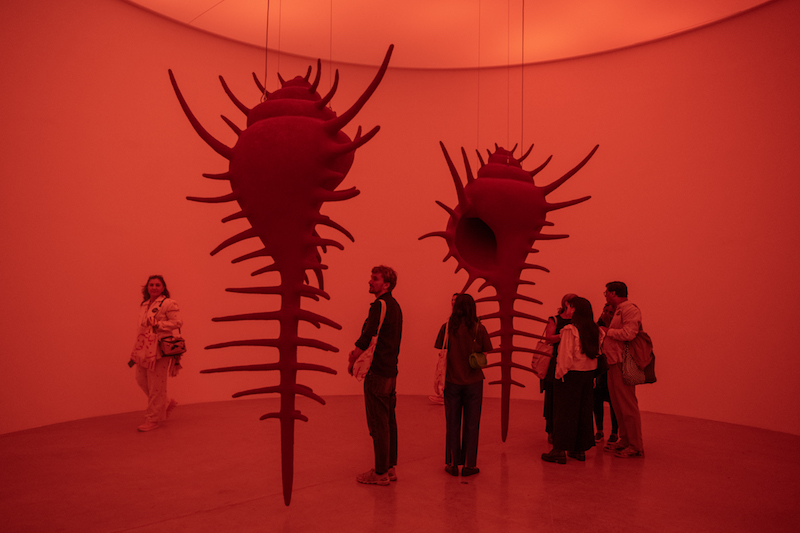
Monira Al Qadiri: ‘Gastromancer,’ 2023, commissioned by Kunsthaus Bregenz with the sponsorship of Rossogranada AG, Zurich, installation view Sharjah Biennial 16, Al Mureijah Art Spaces, Sharjah, 2025 // Photo by Motaz Mawid
Stephanie Comilang: ‘Search for Life II’ (2025)
In ‘Search for Life II,’ Stephanie Comilang draws an unexpected connection between the narratives of pearl hunting and the story of a young half-Filipina, half-Emirati K-pop dancer who shares her experiences of discrimination growing up in the UAE. This expansive film and video installation is “as much about the history of pearling and its commercial and industrialized narratives as it is about the idea of capital, currency and worth within the context of the UAE and concepts of migration,” the artist explained. Centered on pearls as a form of currency and a symbol of speculation, the work weaves together cultures, timelines and themes of desire, trade, glamour and technology. Pearls also form a tangible element of the installation: one of the two screens is a cascading curtain of pearls onto which footage is projected. The screens are separated by a wooden pier that ties maritime contexts together and serves as a platform for viewing the videos from different perspectives. Accompanying the visuals, a musical score emphasizes the importance of song in maritime labor and underscores diasporic experiences in the Gulf states.
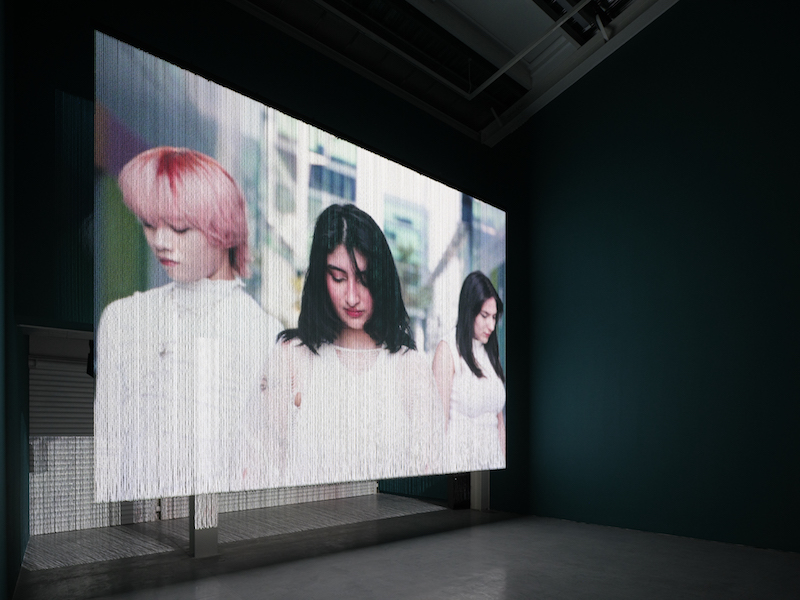
Stephanie Comilang: ‘Search for Life II,’ 2025, commissioned by TBA21, Sharjah Art Foundation and The Vega Foundation, installation view: Sharjah Biennial 16, Al Mureijah Square, Sharjah, 2025 // Photo by Danko Stjepanovic
Hugh Hayden: ‘Brier Patch’ (2022)
One of five Hugh Hayden works on view at Sharjah Biennial 16, ‘Brier Patch’ (2022) is a permanent installation of 100 school desks with boards carved from cedar trees. Tangled branches sprout from the seats, symbolizing a place of learning where unity strengthens individuals, helping them better withstand metaphorical storms. With the installation facing us forward, we’re “standing as if we were the teacher,” Hayden explained. “Depending on where you stand, you also become a student if you approach it from the other direction.” Originally commissioned by Madison Square Park in New York, the work reflects on American classrooms as sites of historical amnesia, cultural assimilation, childhood anxieties and exclusion. Its meaning shifts with location—while trees are scarce in Sharjah, they are abundant in St. Louis, where another iteration of the work is permanently installed in a forest, darkened and overgrown by plants. In Sharjah, the installation will interact with the desert environment, becoming weather-worn and covered with sand, eventually merging with the large dune beside it.
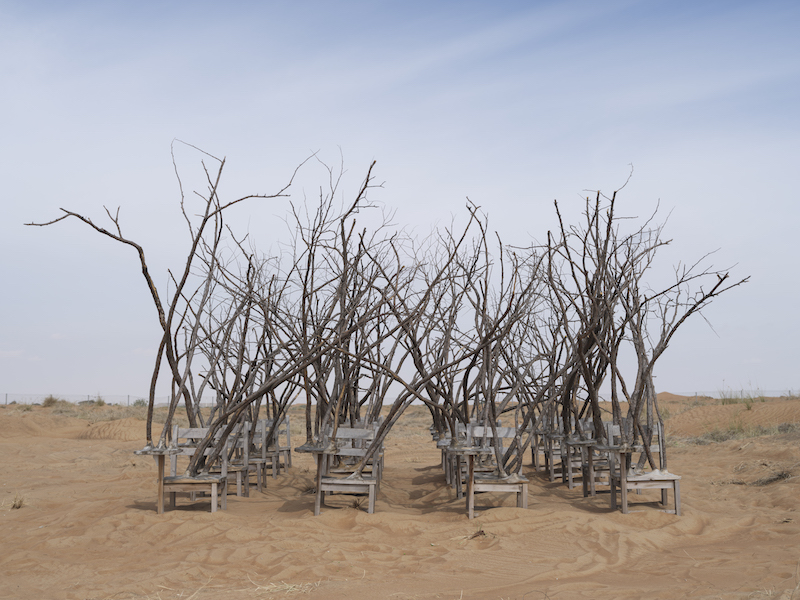
Hugh Hayden: ‘Brier Patch,’ 2022, commissioned by Madison Square Park Conservancy, New York, installation view Sharjah Biennial 16, Al Madam, Sharjah, 2025 // Courtesy of Sharjah Art Foundation, photo by Danko Stjepanovic
Adelita Husny-Bey: ‘Like a Flood’ (2025)
Adelita Husni-Bey’s newly commissioned two-channel video installation looks at the lasting effects of Italian colonization in Libya (1911–1943), focusing on how extraction and forced settlement disrupted the country’s water supply. The video, screened within an evocative installation of large concrete water pipe segments, is built around a recently rediscovered photographic archive, reimagined through a theater workshop at Rome’s Museo delle Civiltà in 2024. From there, it delves into Libyan poetry, exploring how it portrays wells and dams a year after the devastating collapse of the Bu Mansour and Al Bilad dams. Linking the concept of climate adaptability to colonial narratives, the work shows how the attempts to control Libya’s natural elements and Indigenous populations continue to echo through history.
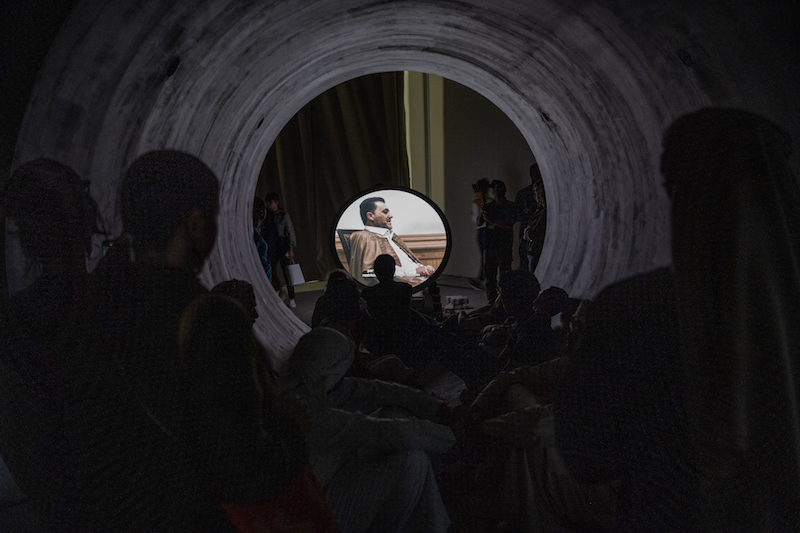
Adelita Husni-Bey: ‘Like a Flood,’ 2025, commissioned by Sharjah Art Foundation and made possible thanks to the Italian Council programme (2024), with Alserkal Arts Foundation, Dubai. Project research conducted in collaboration with Shehrazade Mahassini, installation view Sharjah Biennial 16, Kalba Ice Factory, Sharjah, 2025 // Photo by Motaz Mawid
Zadie Xa with Benito Mayor Vallejo: ‘Moonlit Confessions Across Deep Sea Echoes: Your Ancestors Are Whales, and Earth Remembers Everything’ (2025)
Zadie Xa’s ‘Ghost’ (2025), a mobile sculpture inspired by seashell wind chimes and Korean shamanic rattles, consists of over 1000 chained brass bells that form a conch shell, with a sound component activated when touched. It hangs mid-air within the larger installation, ‘Moonlit Confessions Across Deep Sea Echoes: Your Ancestors Are Whales, and Earth Remembers Everything’ (2025), which Xa co-created with Benito Mayor Vallejo. Inspired by Salpuri, a Korean exorcism dance, the sound installation ‘Confessions under moonlight’ (2025) features a soundscape of folklore, confessions, natural elements and musical notes. Through oracular listening sessions, the audience is invited to commune with the supernatural. “I wanted to think about ways in which we might communicate with people—and when I say people I don’t only mean humans—that have passed on, and what kind of things they would like to impart to us, which is not always going to be nice,” Xa explained.
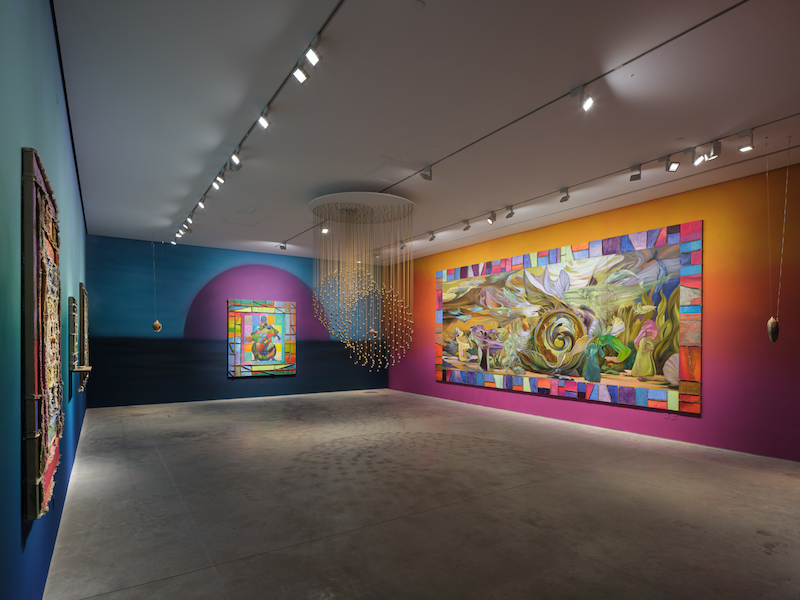
Zadie Xa with Benito Mayor Vallejo: ‘Moonlit Confessions Across Deep Sea Echoes: Your Ancestors Are Whales, and Earth Remembers Everything,’ 2025, installation view Sharjah Biennial 16, Al Hamriya Studios, Sharjah, 2025 // Courtesy of Thaddaeus Ropac, photo by Danko Stjepanovic
Alia Farid: ‘Kupol LR 3303 Talisman’ Series (2025)
Referencing the artist’s collaboration with United Oil Projects Company in Kuwait in the title, ‘Kupol LR 3303 Talisman’ is a series of six newly commissioned panels exploring the material impact of water and oil extraction in the Arab Gulf. Made from layers of polyester resin—a petroleum by-product—the panels embed the artist’s reinterpretation of blue faience, the oldest ceramic glaze dating back over 6,000 years. Farid discovered this material while researching Iraqi artifacts at Stanford University, which were obtained during the US invasion of Iraq. She layers these materials with images tracing her matriarchal lineage as well as Iraqi spiritual traditions, prompting viewers to reflect on ancestry and inheritance. By commissioning this work and presenting it alongside Farid’s 2022 film installation ‘Chibayish,’ curator Amal Khalaf wanted to bring in stories that “recall and remember a way of life that many people in the Gulf have become estranged from—life on the water.”
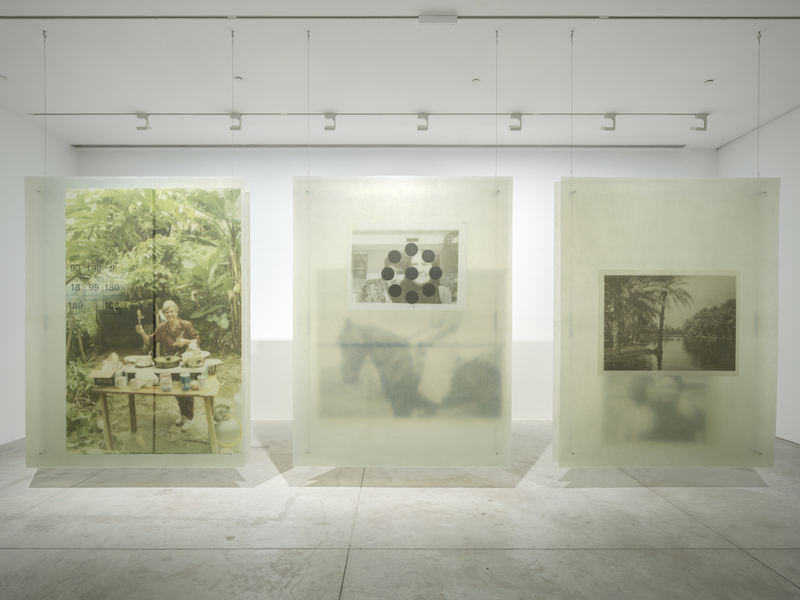
Alia Farid: ‘Kupol LR 3303 Talisman 01, 02 and 03,’ 2025 (right to left), commissioned by Sharjah Art Foundation, installation view Sharjah Biennial 16, Al Hamriyah Studios, Sharjah, 2025 // Photo by Danko Stjepanovic
Rita Mawuena Benissan: ‘You Must Cross and Seek’ (2024)
Commissioned for Sharjah Biennial 16, Rita Mawuena Benissan’s installation weaves together Ghanaian cultural history, ceremonies of Indigenous sovereignty and protocols of Asante custodianship. Through film, photography, sculpture and embroidered tapestry, she explores the spiritual and everyday significance of water for the Ewe people of Ghana’s Volta region, grounding the work in her own ancestral lineage. The work features royal umbrellas, traditional seats and tapestries—symbols of chieftaincy, power and communal rites—that channel ancestral sovereignty and cultural continuity. A projected film animates the umbrellas, evoking coastal life, ceremonial practices and the spiritual dimensions of water. Benissan collaborated with local artisans to build a photographic archive of precolonial and imperial image-making, presenting archival repair and celebration as acts of communal resilience.
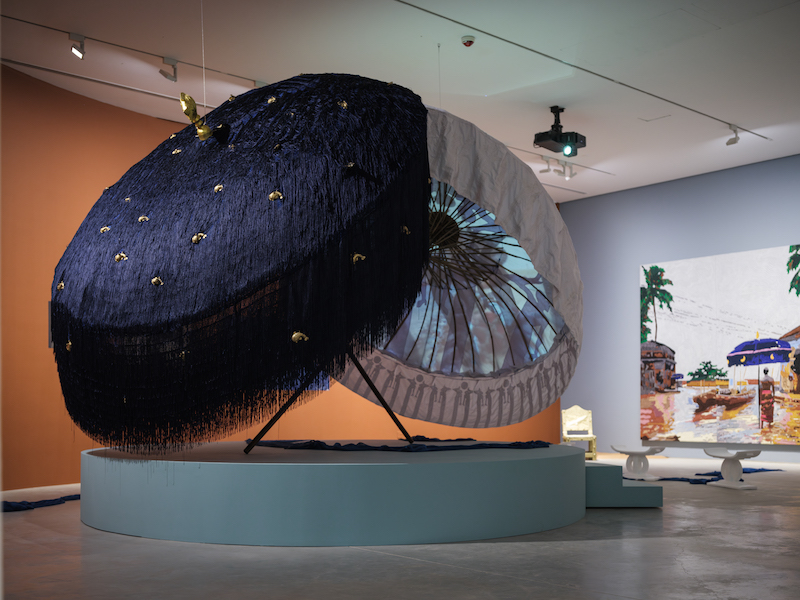
Rita Mawuena Bennissan: various works, 2024, installation view Sharjah Biennial 16, Al Hamriyah Studios, Sharjah, 2025 // Courtesy of Sharjah Art Foundation, photo by Danko Stjepanovic
Wael Shawky: ‘I Am Hymns of the New Temples’ (2023)
An audience favorite, Wael Shawky’s ‘I Am Hymns of the New Temples’ combines reality, fiction and fable. Set in Egypt and the Archaeological Park of Pompeii, the hour-long film weaves together Greek, Roman and Egyptian mythology to create a story about the origins of the universe and the birth of deities. The artist intertwines these different sources across space and time to examine how ancient and contemporary storytelling mechanisms interpret and transmit historical, social and cultural facts. Pompeii, once a thriving trade hub, was home to diverse religious influences, reflected in its archaeological remains. Shawky brings this layered past to life with performances set among the ruins and, by introducing animals into the story, captures the traces of Pompeii’s multispecies iconographies. In this film, performers wear ceramic and papier-mâché masks, replacing the marionettes used in his previous works.
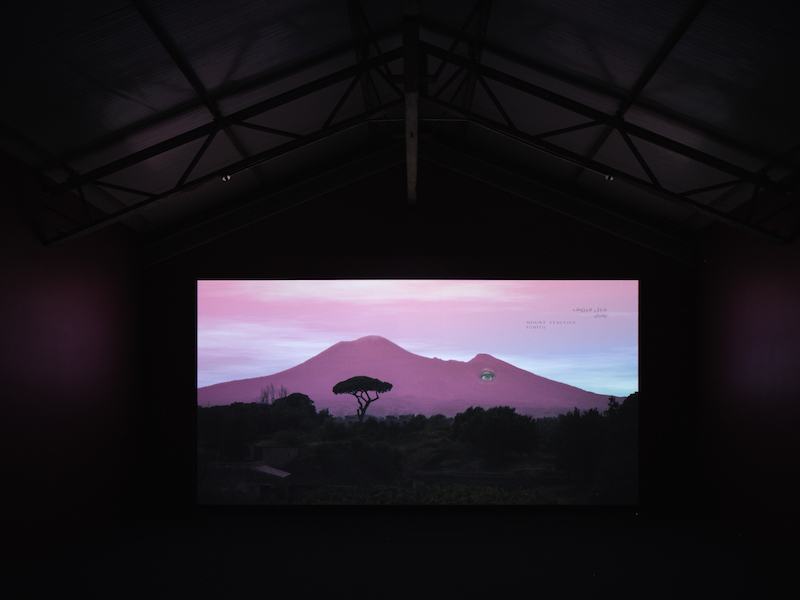
Wael Shawky: ‘I Am Hymns of the New Temples,’ 2023, commissioned by Archaeological Park of Pompeii, in the context of Pompeii Commitment Archaeological Matters; winner of the public notice PAC 2020, promoted by DGCC and MiC, installation view Sharjah Biennial 16, Old Al Dhaid Clinic, Sharjah, 2025 // Photo by Danko Stjepanovic
Sharjah Biennial 16
Group Show: ‘to carry’
Exhibition: Feb. 6-June 15, 2025
sharjahart.org
Various Venues, Sharjah, UAE




















